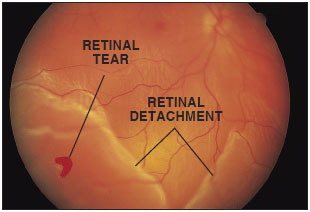Being diagnosed with a retinal tear can be frightening. While it is a serious condition that requires a retina specialist’s attention in a timely manner, it is not uncommon. With early detection and the help of an experienced retina specialist, it can be treated to reduce the risk of vision loss.
If you’ve been diagnosed with a retinal tear, or you suspect you might have one, we’ve laid out some of the most frequently asked questions regarding the condition. If you’re curious about what exactly a retina tear is, the causes of retinal tear, and the dangers associated with the diagnosis, read on to learn more.
The retina is a thin layer of light-sensitive tissue lining the back of the eye cavity. A retinal tear is when a defect opens up in this layer of tissue. The tear or crack in the retina often occurs spontaneously as a result of normal aging, though it can also result from trauma. Roughly 10% of the population will experience a retinal tear at some point.
In addition to trauma, a tear in the retina is also associated with the vitreous gel that exists within the eye separating from the retina as part of the aging process. Tension from the gel may cause damage to the retinal tissue.
Although age remains the biggest risk factor for a tear in the retina, there are several other factors to keep in mind, including:
Because retinal tears are typically painless, in some cases, there are no torn retina symptoms at all, and the condition is discoverable only during a dilated eye exam. But much more frequently, there will be noticeable visual symptoms associated with the tear, such as:

Yes. The greatest danger associated with a retinal tear, and the reason that you should urgently seek professional help if you suspect you might have a torn retina, is to determine whether your retina has detached, and if so, to evaluate the severity of the detachment. Essentially, a detached retina is when the thin retinal tissue at the back of the eye actually lifts away from its normal position, leading to a lack of oxygen and nourishment to the retina—and potentially to permanent vision loss. Surgical intervention is typically required to fix a retinal detachment, and the urgency varies depending on the nature and extent of the detachment.
The location and size of the tear in the retina are important factors. There are some retinal tears that are so microscopic that an ophthalmologist may decide there’s little risk of a retinal detachment and prescribe no immediate treatment at all. If treatment is needed, however, there are typically two methods for treating retinal tears:
In conclusion, retinal tears may be a cause for anxiety, but with timely diagnosis and intervention, progression into a retinal detachment can often be avoided.
At Mid Atlantic Retina, we are the nation’s leading retina specialists for the diagnosis and treatment of retinal tears and detachment. Book an appointment today, and our team will work with you to ensure you receive the proper diagnosis and treatment.